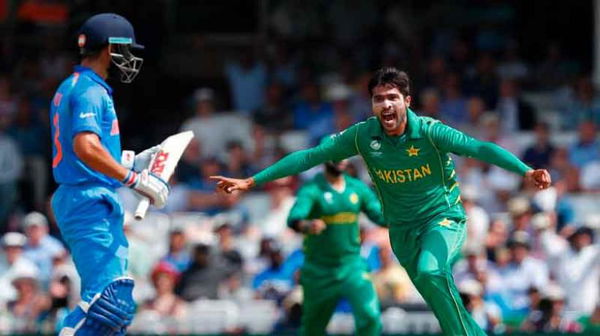
via Imago
inKhabar

via Imago
inKhabar
Before going on to explain why this is wake-up call for the Indian Cricket Team, I would firstly like to congratulate them on playing the brand of the cricket they have in the ICC Champions Trophy. The present day Indian cricket team has started to develop an aura similar to that of the Australian team in the late 90s and the 2000s with its consistent performances, specially in the limited overs format where the team was never hit hard by the transition period. However, there are some definite chinks in the armour which never would have been exposed had it not been for the crushing loss against Pakistan in the Champions Trophy final at Edgbaston.

via Getty
Indian Cricket Team players watch the presentation after the ICC Champions Trophy final cricket match between India and Pakistan at The Oval in London on June 18, 2017. Pakistan thrashed title-holders India by 180 runs to win the Champions Trophy final at The Oval on Sunday./ AFP PHOTO / Ian KINGTON / RESTRICTED TO EDITORIAL USE (Photo credit should read IAN KINGTON/AFP/Getty Images)
What does Indian Cricket need to do?
ADVERTISEMENT
Article continues below this ad
Sorting Out the Middle Order
First and foremost, India need to address their batting order. However strong the Indian batting line-up may appear on paper, also the courtesy of it?s opening batsmen and the ever consistent Virat Kohli, the fact that the current middle order is nowhere even close to the feared batting line-ups India has had before. A lot of fear being instilled by the Indian middle order currently is because of the reputation Yuvraj and Dhoni carry with themselves, and rightly so, for they have been one of the best Indian batsmen in limited overs format.
But, both are nowhere near even 80% of what they were at their prime. Dhoni, who made chases possible from any situation before, used to centre around his game picking singles and running hard between the wickets and putting pressure on the opposition. When he used to settle in after 15-20 balls, he used to strike the odd boundary and hardly played any dot balls. The same Dhoni, since 2014-2015 onwards has been on a decline and has struggled to finish off matches coming at no. 6 or 7.
A few examples are when Kagiso Rabada came up trumps against him in Kanpur (defending 9 in the last over), an unknown Neville Madziva?of Zimbabwe denying Dhoni to finish off the game (8 needed in the last over) in the first T20 of the 3 match series in Zimbabwe in June 2016 and when Dwayne Bravo outfoxed Dhoni to defend 7 runs in the last over when India West Indies played in Lauderhill, USA and a mammoth 489 runs were scored in 40 overs.

via Reuters
India’s captain Mahendra Singh Dhoni plays a shot during their first one-day international cricket match of the Indian Cricket team against South Africa in Kanpur, October 11, 2015. REUTERS/Adnan Abidi
And it?s not as if Dhoni didn?t have any time in any of these innings. In the ODI in Kanpur, he had walked in the 40 over and had faced 30 balls before getting dismissed. In the T20s against Zimbabwe and West Indies, he had played 17 and 25 deliveries respectively. The truth is pretty much clear on the wall that Dhoni has been struggling to finish off games and his batting. The biggest testimonial to that is when Dhoni decided to come up the order and openly spoke about how he wanted to bat for longer periods and how there was a need of someone else finishing the innings.
Even after letting go of the captaincy, he has hardly batted below number 5. And this is the best thing for both Dhoni and India for he gets enough time to settle in and score runs later on.
However, this has started to create a different problem for the team as initially playing dot balls is leading to a loss of momentum thereafter. This year?s IPL was the worst for him in terms of both strike rate and average. A strike rate of just 116 tells the story itself. Moreover, we all know that strike rate is the more important of the two aspects. This means he didn?t even score at 7 runs per over. And citing this weakness, captains tend to bring in 6 fielders inside the circle against the mandatory five. This being said, it?s still very difficult to drop him. He not only doubles as a very smart and probably the best wicket keeper, but also assists Kohli a lot in decision making.
Coming to Yuvraj, who just played his 300 ODI in the semi-final against Bangladesh, there?s no doubt that he still possesses the wonderful timing which made him probably the most effortless stroke-player of his generation, and the fact that he can still pull pacers deep into mid-wicket and take spinners apart even in his sleep, you can?t feel but notice that something is amiss.

via Imago
Yuvraj Singh,of the Indian Cricket Team in action against Pakistan during the group game at Edgbaston. Credits: The Indian Express
Firstly, he?s probably one of the weakest fielders in this Indian cricket team along with maybe Ashwin. This is in stark contest to the man 90s kids had grown up. they have been watching fielding like a tiger at a point and cover with Mohammed Kaif. Secondly, his footwork goes absolutely nowhere when facing top quality fast bowling. Watching Yuvraj stuck in the crease, playing away from his body, without any foot movement against Amir and Junaid. This was not a pretty sight. Anyone could tell that it was just a matter of time before he was back in the pavilion.
Yes, he scored a fifty against Pakistan in the league game and a 150 against England at home However, truth be told, neither of the two teams tested him with bowling full and good length at pace. They had figured out that the southpaw struggled against pace. But what they didn?t realise was when they were bowling short or a yorker length. That way, allowing him to go on the backfoot and play his shots. It not only favoured his stronger suit, but also allowed him those extra seconds to react to the ball. Not only that, but he even struggled in the World T20 2016 at home.

via Reuters
Britain Cricket – Pakistan v South Africa – 2017 ICC Champions Trophy Group B – Edgbaston – June 7, 2017 South Africa?s AB de Villiers looks dejected after he was out Action Images via Reuters / Andrew Boyers Livepic EDITORIAL USE ONLY.
Number 4 is a very important position in any format of the game. Teams that struggled in the Champions Trophy, never had a settled batsman in form at number 4. De Villiers had a bad tournament, Ross Taylor never got going. It made no sense for Australia to play Henriques at number 4, and Sri Lanka never had a fixed number 4. On the other hand, England had Morgan scoring 2 fifties against Bangladesh and Australia. And Mushfiqur scoring 2 fifties against England. Pakistan had Hafeez providing some sort of stability if nothing else. India hardly needed their number 4 before the final except for the group match against Pakistan. Batsmen at number 4 need to provide stability if wickets fall early in the first 10. And provide impetus if they come after 30 overs.
Along with this, he faces the same problem which Dhoni faces,. That is, inability to rotate strike in the first 20-30 balls. With him hardly bowling in the limited overs, he is almost becoming a liability in the field. The technical deficiencies which have crept into his game are very obvious. It?s hard to see him fit into India?s scheme of things for the 2019 World Cup. And at 35, he?s not going to get any younger in the next two years.
Aggressive Intent at the Top
The problem doesn?t end here though and it still has a solution. 50 overs is a long enough time for teams to have 1, or at max have 2 batsmen who take it slow initially. But the Indian team, barring Kohli and Jadhav, has all batsmen which bat similarly, that is taking it very slow in the first 20-30 deliveries including openers Shikhar Dhawan and Rohit Sharma.

via Imago
One of the two between Shikhar Dhawan or Rohit Sharma needs to go a little hard at the top for making Indian Cricket Team proud. Courtesy: India Today
Dhawan, Sharma, Dhoni and Yuvraj Singh all are stroke players and back their ability to accelerate rapidly when they get going, but in modern day cricket where scores of 320-330 are the norm, the collective nature of these batsmen make sure that India never utilise their batting prowess efficiently and even without hitting the 5 gear end up around such scores. Not only that, when they bat for 30 to 50 balls at a strike rate of less than 80 and then get out, they end up harming the final score at least by 10 runs, if not 20 runs.
There have been examples in this tournament as well when the strike rotation in the powerplay has hurt India even when both Dhawan and Rohit scored runs. Against Pakistan at Edgbaston, Rohit scored 91 off 119 deliveries, that is, for 20 overs of the Indian innings the run rate was around 4.5 runs per over and still India went on to score 319 from 48 overs. It won?t happen everyday because you won?t score 72 runs off the last 4 overs against any international side. Not even Afghanistan or Ireland. Against Sri Lanka, Dhawan played a good innings of 125 runs. However, it came off 128 deliveries which failed to make the impact it did.
It can be argued that Dhawan slowed down because India lost wickets in quick succession. However, it hasn?t been a one-off instance. Also, 9 times out of 10, any opening batsman in today?s cricket, after facing more than 120 deliveries will make sure that his strike rate is at least above 100, if not more. To quote Virat Kohli, ?small margins can be massive in this game?.
Looking the bright side, the problem with both Sharma and Dhawan is the mindset. They look very equipped and probably the best to face the new ball. India has had the lowest average score since 2015 World Cup in ODIs amongst the top 8 teams. One of either Dhawan or Rohit need to make sure that one of them is a little more aggressive at the top. Then India can afford someone like Dhoni taking it a little slow. But where do you fit Yuvraj who certainly doesn?t look the part to be number 4.
Solutions
India don?t need to look far for solutions at number 4. They have 2 very good options in their current squad itself in Ajinkya Rahane and Dinesh Karthik. Rahane?s ODI career been a little iffy recently. The lack of clarity over his role as an opener or a middle order batsman has definitely affected his game. He needs to be backed for some time at the number 4 position before being benched as 3 opener.
Apart from Rahane, there are other and the more aggressive options as well which the selectors can look at. Manish Pandey, Dinesh Karthik and Robin Uthappa are some of them. All three of them have been scoring heavily at domestic circuit and are adept at facing both spin and pace. Manish Pandey has been in the squad for a long time now but has been warming the bench. Whereas Karthik and Uthappa have been knocking at the doors of the Indian team as well. The selectors must back them and hope they deliver.
Backing youngsters and taking tough calls:
Kohli has taken the trait of backing a younger player very well from Dhoni, case in point, Hardik Pandya. There?s one more thing which he needs to do as well. Dhoni had gotten rid of Ganguly and Dravid from the ODI team for the tri-series in Australia. This was to build the team for 2011 World Cup. Similarly Kohli will have to take the call on Yuvraj. He will also do well to not be stubborn and sometimes take a gamble or two, like Dhoni did. Kohli would have done well to send Pandya as a pinch hitter in the final. Here?s why.

via Imago
Hardik Pandya enroute his fifty against Pakistan in the ICC Champions Trophy Final. Image Courtesy: The Indian Express
Fixing the 5 bowler conundrum:
Give Kohli time and he?ll learn the tricks of the trade probably as fast as anyone, if not faster. And he has shown it in tests too. He has understood that to win test matches he?ll have to play 5 bowlers to take 20 wickets. While in limited overs the batsmen may win you matches, but don’t forget the cliched saying. It goes as, it?s the bowlers who?ll win your tournaments. And it were the bowlers, who led by Hasan Ali, took Pakistan to their first Champions Trophy title.
Before the beginning of the tournament, the Indian bowling line up looked better than the Indian batting line-up. Bhuvneshwar Kumar, Shami, Bumrah, Umesh Yadav, Jadeja and Ashwin along with Hardik Pandya looked as good as any Indian bowling line-up ever. However, something that went under the notice was the recent form and fitness of the Indian spinners.
Ashwin, in his last 8 ODIs has taken just 6 wickets at an average of 80.50 at economy of 6.44 runs per over. While injuries haven?t played his cause lately and fatigue might have taken a toll. Another issue which comes up is how regularly India have played him in ODIs. Ashwin played just 2 ODIs in 2016 and 6 in 2017. He hasn?t had greater numbers to show for it. The aggressive mindset with which he bowls in tests has been missing lately in the ODIs. And part of the blame should go to the captain in 2016.
Dhoni unknowingly dented Ashwin?s confidence in limited overs by dropping him in the first 3 years ODIs against Australia. And then often bowling Pandya and Jadeja ahead of him in the World T20. The semi-final against West Indies, where Pandya and Jadeja both completed their overs for combined figures of 0-92 in 8 overs. In that, Ashwin bowled only 2 overs. We saw a similar trend in the 2016 IPL where Ashwin didn?t finish his quota in 8-9 games.

via Imago
Not very promising stats. Last 6 ODIs before the Champions Trophy final. One of the finest spinners of the Indian cricket Team.
Coming to Jadeja, qualities that are a boon for him, often turn out to be a bane in limited overs. The predictable line and length without a lot of spin, make it easier for the batsmen to line him up and take him for runs. ?In the last 2 years, Jadeja has played 13 ODIs and taken 11 wickets. His average was just over 60 and an economy rate of 5.5 runs/over. If the last 3 years are considered, the wickets increase to 21 wickets from 24 innings. On the other hand, average drops to 55.14. And economy pretty much remains the same at 5.47 as opposed to Ashwin?s 27 wickets.
Now, how good is Jadeja as a batsman? This has to be considered since it is one of the factors due to which India play him ahead of Ashwin. Also that he?s probably the best fielder in the Indian team, if not the world. In the last 3 years, Jadeja has scored 212 runs at an average of 19.27. His strike rate being 90.98 with a highest score of 32.

via Getty
KOLKATA, INDIA MARCH 18: Ravindra Jadeja, currently in squad of Indian Cricket Team, during the practice session at the Eden Gardens stadium in Kolkata.(Photo by Pankaj Nangia/India Today Group/Getty Images)
Clearly Ashwin is the better spinner of the two and Jadeja?s contribution with the bat hasn?t been very substantial. With the kind of batting line-up India has, they should back their top 6-7 to do the job. They should have proper wicket taking bowlers who can have an impact rather than going for fail-safe options. Pandya, in his short career and through his performance in the IPL has shown that he can be really good striker. However, he can?t be relied with 10 overs every game. At one point in the final, it really looked like Pakistan could get 350 if Pandya would have had the kind of ordinary days he has had with the ball.
The writing is on the wall is pretty much clear for India. Only one of Pandya/Jadeja can play in the XI and neither can be looked at as a frontline bowler. Pandya the better batsman, Jadeja the better bower and a marginally better fielder.
Who’ll be the 2nd spinner? Leg-spinner or Chinaman Bowler?
ADVERTISEMENT
Article continues below this ad
To look at a second spinner in the team, India should consider either Amit Mishra, Yuzvendra Chahal or Kuldeep Yadav. A Leg Spinner is not only a wicket taking option, but also adds an element of variety in the bowling attack. Adil Rashid took 7 wickets from his 3 matches at an average of 20.28 and an economy of 4.73. Imran Tahir took 5 wickets from his matches at an average of 16 and an economy of 4.32. Not only that, but he was the man of the match against Sri Lanka for his brilliant bowling. In the last 3 years, Tahir has taken 85 wickets from 50 innings at an average of 25.37 and an economy of 4.83. On the other hand, Rashid has picked up 67 wickets in 44 innings at an average of just above 31 and economy of 5.6.
The average improves to 27.50 for Rashid if we consider the last two years and the economy improves to 5.35. The success of both these spinners show their effectiveness. How efficacious they have been while playing most of their matches in conditions which suit fast bowling more than spin. And still they have been able to prize out wickets. Tahir has also been more economical than both Ashwin and Jadeja. He has proved the conventional theory of leg spinners being expensive wrong.

via Imago
Imran Tahir celebrates his dismissal of Dhananjaya de Silva, South Africa v Sri Lanka, 5th ODI, Centurion, February 10, 2017
?Associated Press
While Amit Mishra has been around for some time and hasn?t done much wrong, it?s hard to see selectors backing him because of his age. What also went against him is his fielding and fitness. Between Yuzvendra Chahal and Kuldeep Yadav, it seems that Kuldeep Yadav has the edge. The reason being that his name was present in the squad for the ODI series against the West Indies.
ADVERTISEMENT
Article continues below this ad
There was never a doubt about the class and quality of the Indian team. Despite the loss to Pakistan in the final, it still remains one of the top in the world. However, what needs to change is a slight change in the approach. The Indian cricket team needs to be a little more flexible and play its best XI which can create maximum impact. Back the top 6 to get runs, and the other 5 bowlers to restrict the opposition. As simple as it gets.
ADVERTISEMENT
ADVERTISEMENT
ADVERTISEMENT
ADVERTISEMENT

